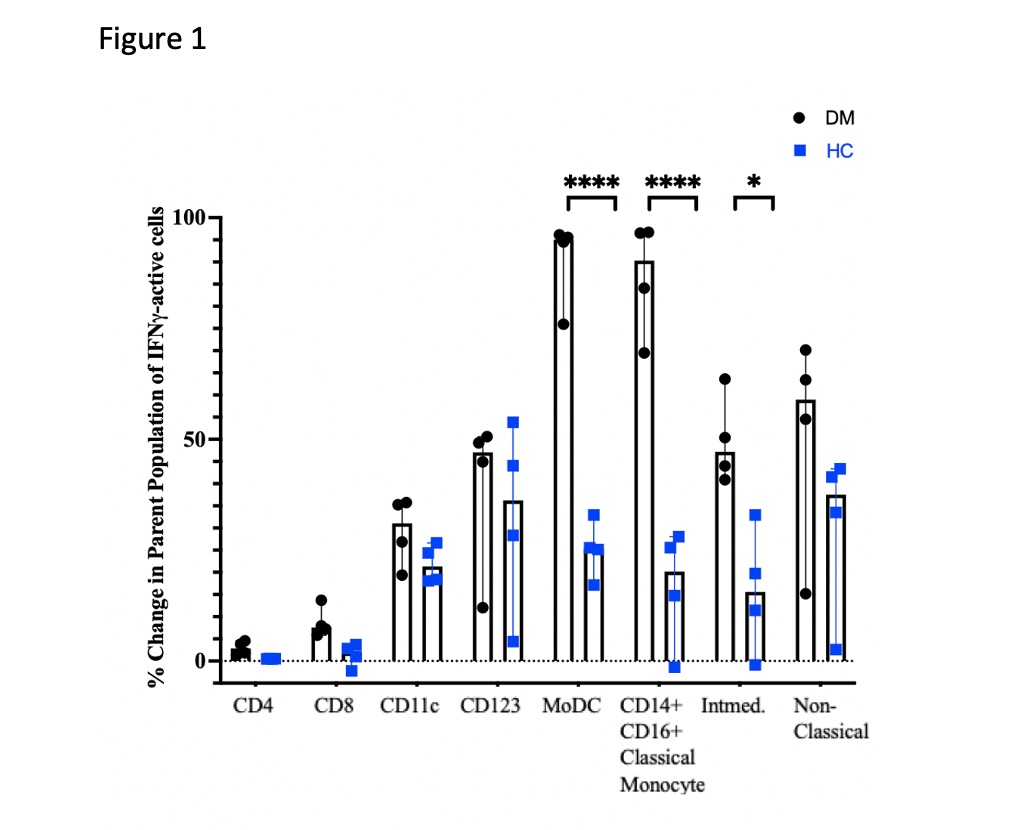Session Information
Session Type: Poster Session B
Session Time: 8:30AM-10:30AM
Background/Purpose: Our group has previously shown that Spirulina, a popular herbal supplement with purported immune boosting effects, is temporally associated with dermatomyositis (DM) onset and flare. We have previously shown in vitro that Spirulina induces IFNγ.
Methods: Here, we sought to identify which cells and inflammatory pathways are activated as a result of Spirulina stimulation in DM patients. Given the important differences between the blood and end organ immune compartments, we sought to interrogate the effects of Spirulina in both blood and skin. We utilized multiplexed flow cytometry on DM patient PBMCs stimulated with 0.3mg/mL of Spirulina. Using GraphPad prism V8.4.3, comparisons between healthy controls and DM were made with Students t-test and comparison of multiple groups were made by one way ANOVA with a post hoc Tukey test. Correlations were analyzed with Pearson’s r. With flow cytometry, we investigated Spirulina’s immunostimulatory effects at the cellular level. Eight cell lineages were evaluated in PBMCs using FACS Symphony A3 Lite and analyzed with FlowJo V10.7.1.
Results: When evaluating % change in activation with 0.3 mg/ml of Spirulina in DM and HC for IFNγ, monocyte-derived DCs (moDCs) and classical monocytes (CMs) had a significantly greater % increase in CMs and moDCs in DM compared to HC (Figure 1). With stimulation at 0.3 mg/mL of Spirulina, the IFNγ+ moDCs MFI increased by 11.7 fold relative to no stimulation (p< 0.0001). The MFI of CMs secreting IFNγ increased 32.0 fold with 0.3 mg/mL when compared to no added Spirulina (p< 0.0001) (Figure 2a and 2b). Pre-treatment with TLR4 inhibitor prior to Spirulina 0.3mg/ml of stimulation suppressed the MFI of IFNγ activation by 63.07% in moDCs, and by 73.4% in CMs (p< 0.05 and p< 0.001, respectively). We then performed imaging mass cytometry on lesional DM skin from patients with new-onset DM and a clear history of novel Spirulina consumption in the immediately preceding period (Spir-DM). Unsupervised clustering of dermal cells using the Phenograph algorithm yielded 14 unique cell types. MoDCs were manually gated on CD14 and CD11c. CMs, were the predominant cell type (16.1%), followed by CD4 T cells (14.6%), CD163+ macrophages (9.6%), and moDCs (9.3%). There was overlap of CD14, CD11c, and IFNγ in Spir-DM skin, supporting an important role for moDCs and CM in the production of IFNγ. We then compared IFNγ and TLR4 expression in DM (Figure 3a) and Spir-DM (Figure 3b), finding a stronger positive correlation in Spir-DM (r=0.97) than in DM alone (r=0.73).
Conclusion: These results further implicate Spirulina as a likely culprit in the development of DM in some patients. Our data suggest that Spirulina may promote autoimmunity via production of IFNγ in CMs and moDCs in both the blood and skin, thereby implicating Spirulina in the development of DM in some susceptible patients.
To cite this abstract in AMA style:
Diaz D, Vazquez T, Bax C, Patel J, Grinnell M, Keyes E, Li Y, Werth V. Spirulina Activates IFNγ via TLR4 in Dermatomyositis Skin and Peripheral Blood [abstract]. Arthritis Rheumatol. 2021; 73 (suppl 9). https://acrabstracts.org/abstract/spirulina-activates-ifn%ce%b3-via-tlr4-in-dermatomyositis-skin-and-peripheral-blood/. Accessed .« Back to ACR Convergence 2021
ACR Meeting Abstracts - https://acrabstracts.org/abstract/spirulina-activates-ifn%ce%b3-via-tlr4-in-dermatomyositis-skin-and-peripheral-blood/



